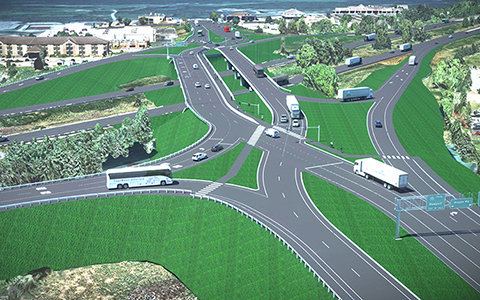
With an average of 35,000 vehicles traveling through the highway daily, the Exit 187/Hogan Road crossing on I-95 in Bangor is one of the busiest diamond interchanges in Maine. Although it is an important connection point for regional and local travelers, this portion of the roadway is characterized by safety concerns, heavy congestion, and lack of adequate bicycle and pedestrian access.
Recognizing the need to address these issues and provide safer transportation for all users, the Maine Department of Transportation (MaineDOT) decided to implement a Diverging Diamond Interchange (DDI) at this location and retained VHB in the fall of 2015 to provide traffic simulations to demonstrate that a DDI can provide acceptable operations. VHB used the simulation model to develop visualizations for public presentation. In 2018, MaineDOT retained VHB to provide preliminary engineering services for the DDI to help solve the existing safety, congestion, and access concerns for vehicles, pedestrians, and cyclists.
What is a DDI?
The continuous pursuit of improved traffic operations and safety has led to an evolution of thought in interchange project development and design. The DDI is one such innovation and has proven effective at increasing traffic capacity, decreasing delay, and reducing vehicle conflict points at other interchange locations across the country. A key feature of the DDI is the signalized crossover intersections at the ramp terminals. The design applies unique geometry and simplified two-phase traffic signals to shift traffic on the arterial street to the left side of the median between the ramps; this allows all turns to and from the ramps to be made without crossing opposing traffic. The simplified signal phasing reduces traffic delay, while the unopposed turning movements promote smoother travel to and from the ramps. When applied at diamond interchanges with high turning volumes and moderate or unbalanced through volumes, the DDI has been successful in increasing capacity while requiring less infrastructure in terms of turn lane storage and wider bridge structures.
DDI Benefits
A DDI has the potential to offer several benefits compared to its conventional diamond counterpart. From an operational perspective, the two-phase signals at the crossover intersections can improve capacity, reduce delay, and promote better coordination with adjacent traffic signals on the corridor. From a safety perspective there are several advantages:
Fewer Conflict Points: A DDI has fewer conflict points (18) than a conventional diamond interchange (30), while the geometry and signal operations at the crossovers foster lower speeds for through traffic, which reduces the frequency and severity of crashes within the interchange area.
Improved Capacity: The improved capacity enables more vehicles to be accommodated with less infrastructure, which can translate to lower project costs for construction, right-of-way acquisition, and utility relocation.
Reduced Traffic Delay and Carbon Emissions: The reduced traffic delay and simplified traffic signals can bring environmental benefits through the reduction of vehicle idling and emissions within the interchange area.
Pedestrian Safety: The DDI is also flexible in its ability to accommodate pedestrians and bicyclists safely and effectively through the interchange, incorporating wayfinding, crosswalks, and cross signaling.
VHB has been an integral part of the preliminary engineering with ongoing highway and traffic design components including horizontal and vertical alignments; intersection grading; street and pedestrian lighting; ramps; traffic signals; construction phasing; drainage; shared-use path; retaining walls; and ADA compliance. VHB was recently selected by MaineDOT to complete the final design for not only the interchange ramps and roadways but also the bridge component of the Bangor DDI project as well. Construction is anticipated to begin in spring of 2025.
VHB is proud to support MaineDOT on this highly innovative effort—the first of its kind for MaineDOT—and continue contributing to efforts that enhance the safety and the long-term well-being of our local communities.
VHB not only delivers local projects to our communities but is also active on a national level through our Federal Safety Practice. We routinely engage with industry leaders across the U.S. and internationally on emerging topics in transportation and safety and are constantly monitoring the state of the practice. VHB is actively developing an informational guide for the Federal Highway Administration Office of Safety focused on improving walking and biking at intersections, including innovative designs like the DDI.
Learn more about how VHB's Transportation/Highway Engineering and Design teams support StateDOTs.


